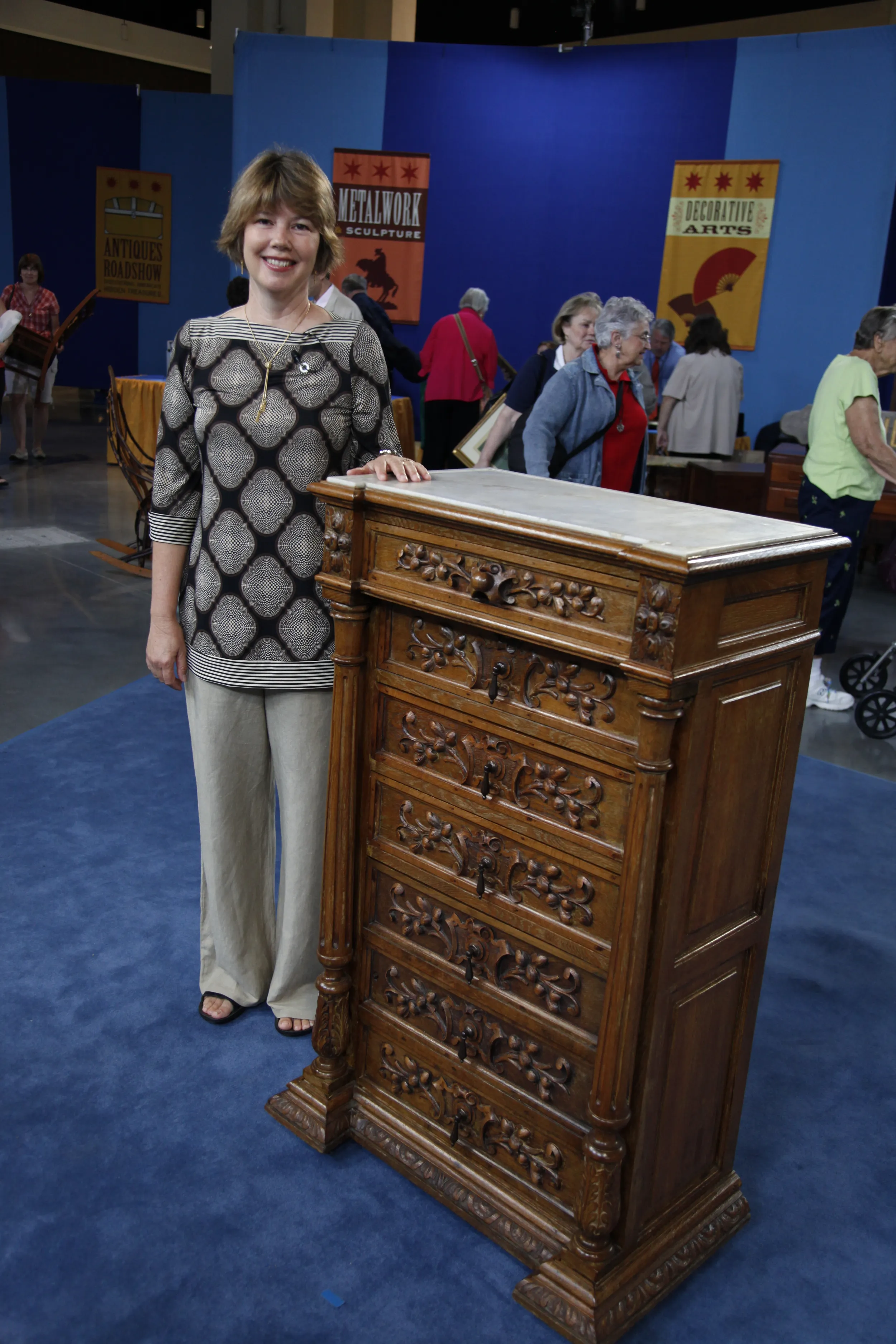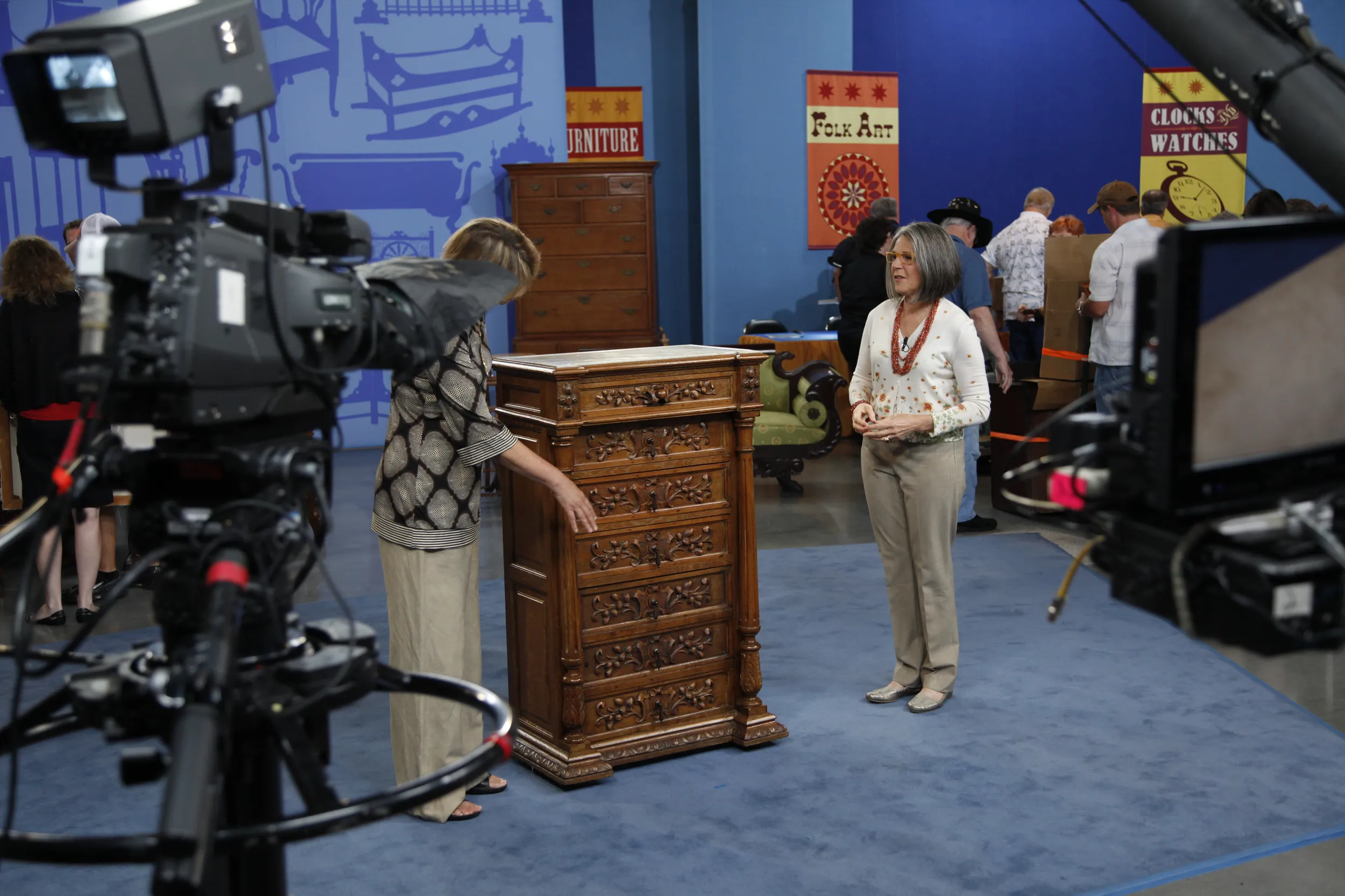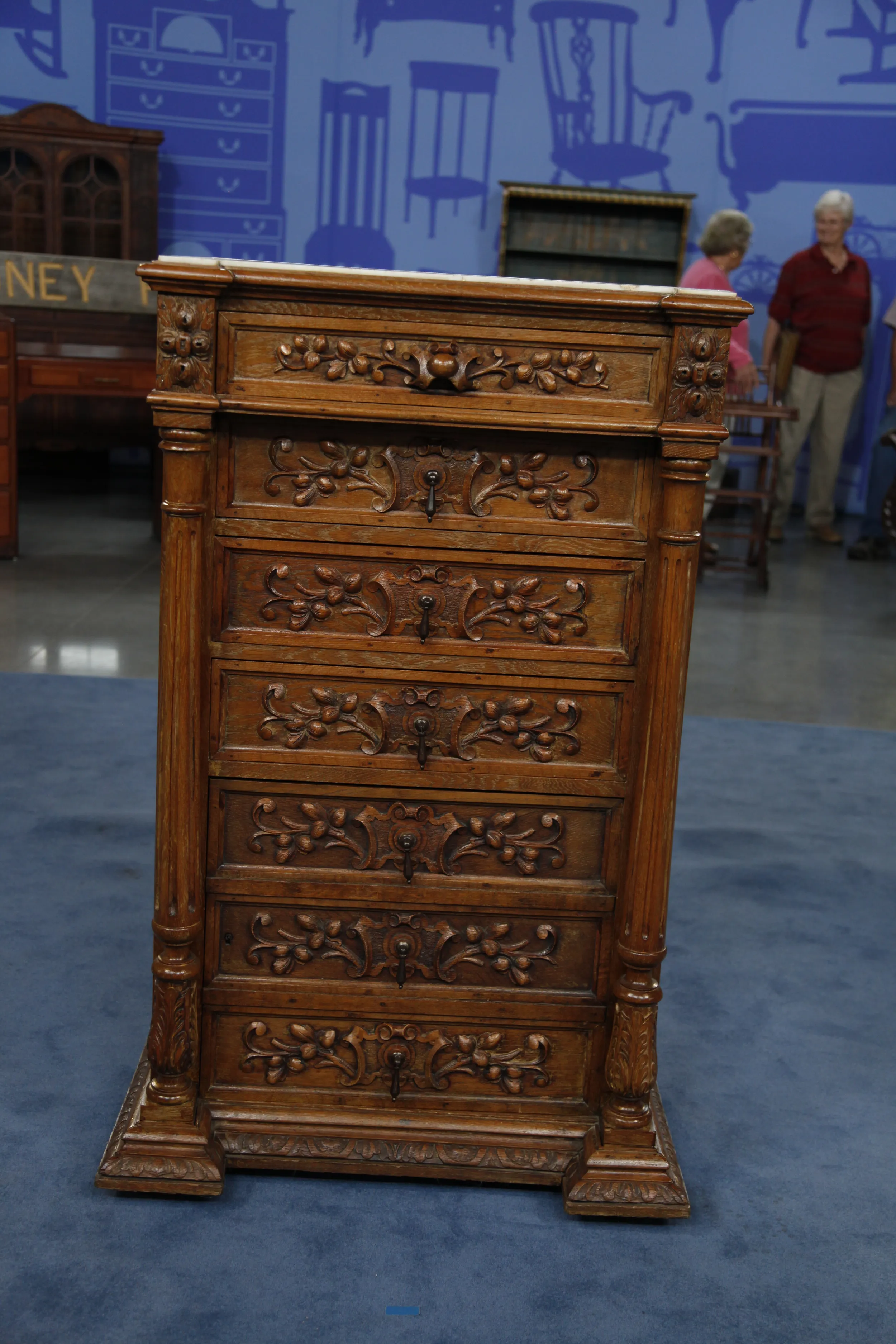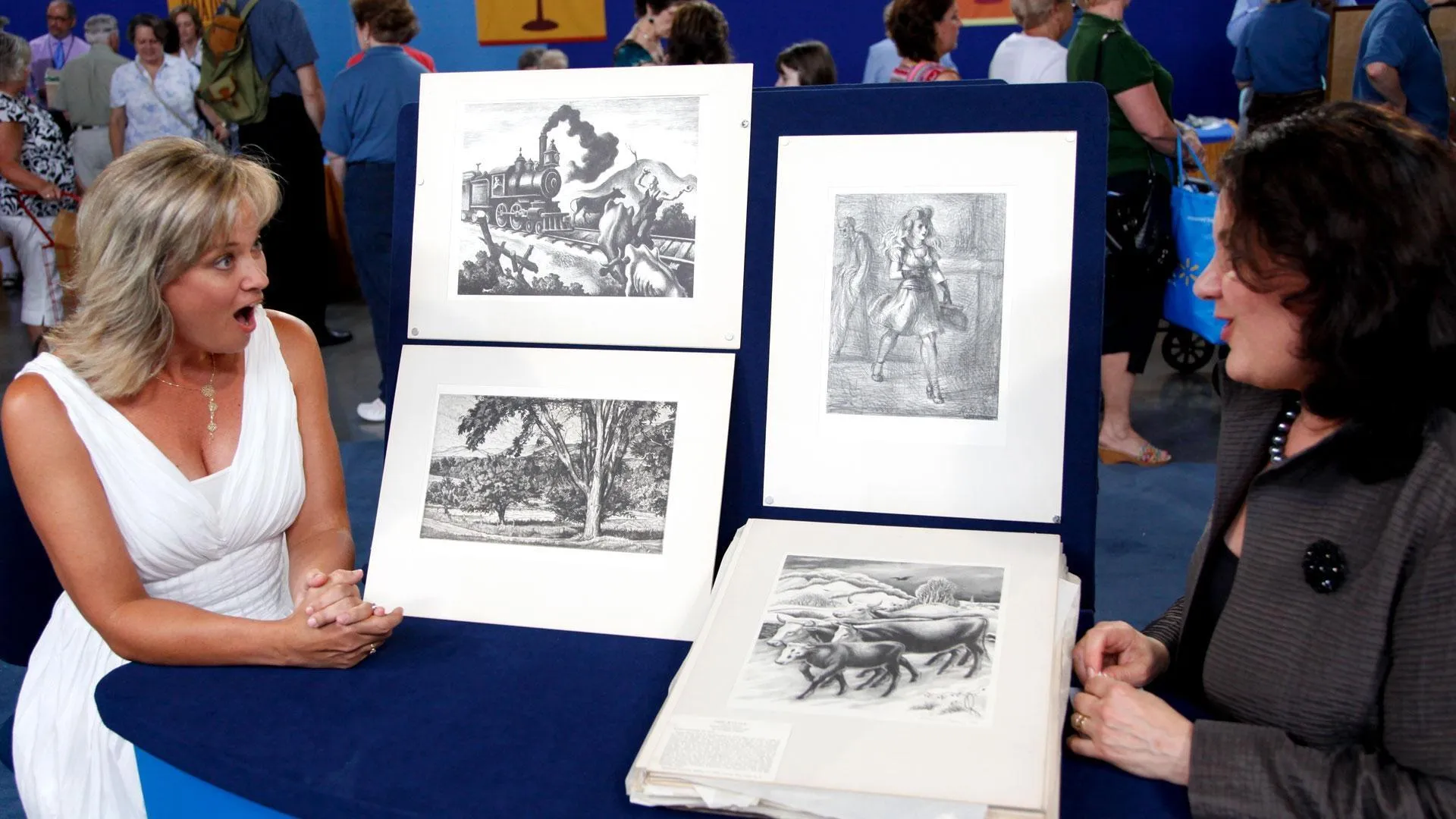Marble-top Semainier, ca. 1880
GUEST: It's a semainier-- I guess I'm pronouncing that correctly, I'm not sure-- a seven-day chest. I believe it's oak, and I believe it's from Louisiana, according to my father's notes, but I'm not sure. The top three are drawers and the bottom is a chamber.
APPRAISER: Yes. The interesting thing about this semainier-- and you're absolutely right, it is seven-drawer chest-- is that originally, these were made in the 18th century, and it's a French form. Semainier refers to the week, French for week.
GUEST: Right.
APPRAISER: And during the 18th century, it is what a very wealthy woman would keep her lingerie in.
GUEST: Oh.
APPRAISER: And, of course, there are seven drawers, so that you have clean lingerie...
GUEST: (laughs)
APPRAISER: ...for each day of the week, and you don't make any mistakes.
GUEST: Okay. (both laugh)
APPRAISER: This piece, however, was made in the 19th century.
GUEST: Mm-hmm.
APPRAISER: And it's a copy of an 18th-century form.
GUEST: Okay.
APPRAISER: Semainiers from the 18th century are very rare, and I believe it to be made probably in France. It's a continental piece of furniture.
GUEST: Okay.
APPRAISER: It's a family piece of yours.
GUEST: Well, he bought it in 1966.
APPRAISER: Okay, okay. So you've had it since the '60s.
GUEST: Correct.
APPRAISER: The other point is that there's a really wonderful shaped marble top. It's got a little bit of damage on it.
GUEST: It does.
APPRAISER: But it doesn't bother me too much.
GUEST: Okay.
APPRAISER: I mean, there's cracking. You can see a little fill going on here, but other than that, it is original, and that really sort of adds to the piece. Well, it's got a very, very nice honey-colored oak finish. I think originally at one point, this piece had been painted, and then someone took the paint off.
GUEST: Hm, wow.
APPRAISER: And it's interesting that you say it was bought in the 1960s, because there was a real fervor in the '50s and '60s to refinish furniture. Now, this piece was never originally, in the 19th century, painted. It was a beautiful oak wood when it was original. Someone probably painted it. And you can see, actually, if you look in some of the crevices of the carving...
GUEST: Mm-hmm.
APPRAISER: You'll see a little tan color.
GUEST: Yes.
APPRAISER: I think that's probably the paint at one point.
GUEST: Wow.
APPRAISER: And they took it off. We talk all the time about, "Don't refinish furniture." I mean, sometimes you've got to.
GUEST: Right.
APPRAISER: If you have a 19th-century piece of furniture that was supposed to be original, in its original wood, and you've got paint on it, you're caught between a rock and a hard place.
GUEST: Right.
APPRAISER: You've got to take the paint off.
GUEST: Right.
APPRAISER: And whoever did this did a really lovely job.
GUEST: Oh, great.
APPRAISER: The other thing, in terms of quality on this, it's got these really wonderful bronze teardrop pulls.
GUEST: Mm-hmm.
APPRAISER: And, of course, this was made 19th century, and they loved to sort of shake up designs in the 19th century. And so instead of having the seven drawers, as you say, there's a cabinet at the bottom. And could you show us the cabinet? How that works?
GUEST: Certainly.
APPRAISER: I would guess that probably being in a bedroom during the 19th century, you would have needed a spot, a tall spot, to put away your bowl and pitcher for washing up. So it's sort of three faux drawers below and four real drawers in the top. These lovely pilasters on either side that are carved, it's really just a charming piece of French furniture, evocative of the 18th century, but really a much heavier, beefier form, because, of course, in the 19th century, furniture was much heavier. We see the wood oak used more prevalently in the last quarter.
GUEST: Right.
APPRAISER: So, say, 1875 to 1890. Did your dad ever tell you what he paid for it?
GUEST: Well, my mother told me the story that they were coming home from New Orleans, antiquing. They drove through Slidell, Louisiana.
APPRAISER: Mm-hmm, mm-hmm.
GUEST: And they saw an ad in the classifieds for this, at a private residence. They went, the woman wanted $250 for it.
APPRAISER: Mm-hmm.
GUEST: And they said they would think about it. They drove all the way home to Gulfport, sat in the driveway and said, "We were crazy not to buy that." Didn't even get out of the car, drove back, and bought it for $250.
APPRAISER: Now, have you had this appraised before?
GUEST: I had it appraised recently. It was $4,500, which I thought was a little high.
APPRAISER: I would say it's aggressive, also. I would say today, if you were driving through Louisiana, and you saw a piece like this in a shop, that you would expect to pay in the $2,000 range for it.
GUEST: Okay.
APPRAISER: I mean, it's a... it's a wonderful piece. It's honest, it's in its original condition, just short of that refinishing.
GUEST: Right.
APPRAISER: But it doesn't bother me at all. It's got great carving on it. It's a lovely, charming piece.
GUEST: Great, thank you.

$2,000 Retail
Biloxi, MS
Photos




Featured In

episode
Biloxi, Hour 3
ROADSHOW surveys the influence of southern landscapes in the work of Walter Anderson.
Cultural Art & Objects

appraisal

appraisal

appraisal

appraisal
Understanding Our Appraisals
Placeholder





